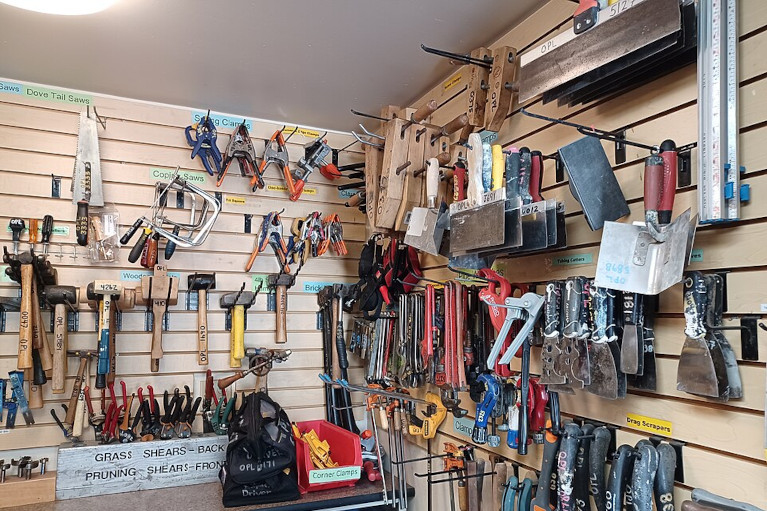Tool libraries can simultaneously increase access to material goods and decrease total material usage. It’s time to deploy them at scale, says Paddy Le Flufy in an excerpt from Building Tomorrow: Averting Environmental Crisis With a New Economic System.
In the last few decades our material consumption has increased enormously, and with it, so has our production of waste. There are many statistics demonstrating that we are throwing away far too much stuff. Here is one of them: the electronic waste that’s discarded each year weighs more than all the commercial aircraft ever built.
That’s a lot of waste being produced every single year. And it is currently only providing part of the world’s population with a good material quality of life. If everyone else attains a similar level of consumption in the same way and we keep it going for another generation or two, the world will begin to resemble a gigantic rubbish dump. Something is going to have to change.
An essential element of solving this problem is simply using less stuff. We are already using immense amounts of resources, but there are still billions of people in poverty. For everyone in the world to have access to enough material goods, we will need to share that access much more effectively.
Looking at this issue as being about people having enough access to goods rather than owning those goods themselves is a powerful way of framing the issue that opens up a whole new set of solutions. The Toronto Tool Library is one of the pioneers of one such solution: libraries of things.
Libraries of things are exactly what they sound like; they are just like book libraries, except that instead of stocking books, they stock things. Tool libraries are a specific subset of libraries of things that specialise in tools. Toronto Tool Library is one of these. For a small annual fee, members can have access to many thousands of tools when they need them.
While libraries of things have great potential, they are more suitable for some classes of items and less so for others. For example, for items that are used very regularly it would be impractical to try to borrow them only when needed. And items that are used seasonally, such as camping equipment, can be hard to accommodate into a library of things model because the library needs to store them out of season, which can cause problems if space is limited.
Tools are a class of items that are particularly suited to the library approach. It is almost a cliché, in the sharing economy world at least, to say that the average drill is used for about 13 minutes in its lifetime. I don’t know where that specific statistic originated, but the idea is sound. Each person or family only uses a drill occasionally, but because everyone does need one sometimes, conventionally, each household needs to own one. It would be much cheaper and more environmentally friendly for many households to share one drill, each being able to access it when they need it. This is what a tool library allows us to do.
The Toronto Tool Library has taken this much further than drills. It was started in 2012 by a group of friends who wanted to create local change in communities after one of the founders, Ryan Dyment, heard about an early tool library that had opened in the 1970s in America. They did it on a shoestring – having started a non-profit and won a small grant, they borrowed a basement to use as the library and relied on donations of tools to get their inventory going.
‘Relied on donations’ makes it sound like it was difficult to get going, but in fact they found that once people heard about them, they were positively eager to give them tools. So many people had old tools hanging around in their garage they didn’t really need that ‘the phone was ringing off the hook’ according to Dyment. They were well-organised and professional, and quickly got good publicity that enabled them to grow, and they now have thousands of tools available.
But it is not easy to organise and run a successful library of things. One challenge all libraries of things need to overcome is funding. They are very capital-intensive because they need a brick-and-mortar shop and people to staff it.
One solution to this problem is not to have libraries at all, but instead use a peer-to-peer lending model. In this model, people use a platform website to offer their own goods for others to borrow (for a small fee). This model works very well for expensive and specialist items, like high-end cameras, drones, and laboratory equipment, and such platforms exist. For example, Fat Llama offers this service for individual-to-individual lending, and Rheaply does so for lending within and between organisations. But this system doesn’t work for tools and other less valuable items. For peer-to-peer lending to work, people need to have an incentive to lend, as well as borrow, items. Expensive pieces of kit can be hired out at a rate that makes it worth people’s while to offer them, but this is not the case for cheaper items.
In the case of tools, there is another problem. When you need to do a DIY job, you usually need to borrow various items at once. With peer-to-peer lending this could mean you need to borrow from multiple people, but as you need to personally collect each item from its lender, this can quickly become more hassle than it’s worth. Tool libraries don’t have this problem because all the tools are in one place, and with a little thought, they can save their members even more hassle. Toronto Tool Library offers tool packs to cover specific jobs so members don’t need to work out exactly what they need themselves.
This leaves the funding problem unresolved. It is normal for tool libraries to charge a membership fee, plus a day rate for some items – Toronto Tool Library does this for battery-powered, bench-top, and high-maintenance tools. But it’s difficult to balance an affordable price with covering the costs of the equipment to lend, the people to staff the library and, most importantly of all, the cost of renting and running the physical premises.
This brick-and-mortar cost is currently the main obstacle to scaling the idea and opening tool libraries around the world, but there is a potential solution, and the clue is in the name: tool ‘library’. Libraries are, in many countries at least, a public service. It’s easy to make a case that tool libraries should also be provided as a public service, free of charge, so that everyone has the ability to make and repair things. It’s possible that a government would agree with this and fund the provision of tool libraries. However, that does seem quite unlikely at the moment.
Another solution is philanthropic funding, and this too has a precedent. In the late nineteenth and early twentieth centuries, the businessman and philanthropist Andrew Carnegie part-funded the creation of 3,000 libraries. He paid to build and equip them, so long as the local authority provided the land and covered the running costs.
A similar arrangement could be organised to create a network of tool libraries, with philanthropic funding paying for the buildings and the initial tools and either government funding or membership fees paying for the ongoing costs. This is a much more realistic goal: 200 of the world’s richest people have pledged to donate half of their wealth to philanthropy, and some of them are a long way from having done so. A clear, well-structured plan to set up a global network of tool libraries, in which philanthropists cover the initial capital costs and suitable local people run the libraries as non-profit entities, might be a good way for some of them to get closer to fulfilling their pledge.
There are also ways for individual tool libraries to get funding or space themselves. For example, Saint John Tool Library in New Brunswick couldn’t get any social enterprise funding to begin with, so they started a construction business operating out of their tool library. Once they had built up their library membership, they turned the construction business into a training program to help people struggling with unemployment get into the trades.
The problem of finding a space for a tool library can be solved by looking for unused spaces, such as the spare basement in which Toronto Tool Library began, or by businesses supporting their local community through providing space for a tool library.
Between finding creative ways to bootstrap a tool library and persuading philanthropists to fund capital costs, there will be many opportunities to solve the funding issue and found more tool libraries. It is important we do: tool libraries have the potential to simultaneously decrease material usage and increase access to material goods, both of which are needed if we are to create a more equitable and ecological society.





